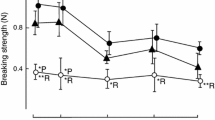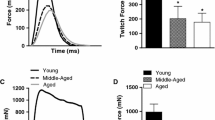Abstract
Bilateral asymmetry of the paired snapper/pincer claws may be reversed in adult snapping shrimps (Alpheus heterochelis). Removal of the snapper claw triggers transformation of the contralateral pincer claw into a snapper and the regeneration of a new pincer claw at the old snapper site. During this process the pincer closer muscle is remodeled to a snapper-type, and these alterations have been examined with the electron microscope. There is selective death of the central band of fast fibers, accompanied by an accumulation of electron-dense crysttaline bodies in the degenerating fibers. Two principal types of hemocytes (amebocytes and coagulocytes) invade the area and the degenerating muscle fibers. New myotubes also appear in this central site. The myotubes are characterized by a prolific network of presumptive sarcoplasmic reticulum and transverse tubules, nascent myofibrils, and crystalline bodies. The myotubes are innervated by many motor nerve terminals, and they subsequently differentiate into long-sarcomere (8–12 μm), slow muscle fibers. Remodeling of the central band, therefore, occurs by degeneration of the fast fibers and their replacement by new slow fibers. Remnants of the degenerating fast fibers act as scaffolding for the myotubes which originate from adjacent satellite cells. The crystalline bodies may represent protein stores from the degeneration of the fast fibers, recycled for use in the genesis of new fibers. The invading hemocytes appear to play several roles, initially phagocytosing the fast muscle fibers, transporting the crystalline bodies into the new myotubes, and acting as stem cells for the new muscle fibers. Apart from the central band of fibers, the remaining pincer-type slow fibers with sarcomere lengths of 5–7 μm are transformed via sarcomere lengthening into snapper-type slow fibers with sarcomere lengths of 7–12 μm. Thus, during claw transformation in adult snapping shrimps, the pincer closer muscle is remodeled into a snapper closer muscle by selective death of the fast-fiber band, replacement of the fast-fiber band by new slow fibers, and transformation of the existing slow fibers to an even-slower variety.
Similar content being viewed by others
References
Alley KE (1989) Myofiber turnover is used to retrofit frog jaw muscles during metamorphosis. Am J Anat 184: 1–12
Bateson RG, Woodrow DF, Sloper JC (1967) Circulating cells a source of myoblasts in regenerating injured mammalian skeletal muscle. Nature 213: 1035–1036
Beaulton J, Lockshin RA (1977) Ultrastructural study of the normal degeneration of the intersegmental muscles of Antheraea polyphemus and Manduca sexta (Insecta, Lepidoptera) with particular reference to cellular autophagy. J Morphol 154: 39–58
Crossley AC (1972) Ultrastructural changes during transition of larval to adult instersegmental muscle at metamorphosis in the blowfly Calliphora erythrocephala. I. Dedifferentiation and myoblast formation. J Embryol Exp Morphol 27: 43–74
Govind CK, Pearce J (1988) Remodelling of nerves during claw reversal in adult snapping shrimps. J Comp Neurol 268: 121–130
Govind CK, Mearow KM, Wong A (1986) Regeneration of fiber types in paired asymmetric closer muscles of the snapping shrimp, Alpheus heterochelis. J Exp Biol 123: 55–71
Govind CK, Mellon DeF, Quigley MM (1987) Muscle and muscle fiber type transformation in clawed crustaceans. Am Zool 27: 1079–1098
Govind CK, Kirk MD, Pearce J (1988) Highly active neuromuscular systems in developing lobsters with programmed obsolescence. J Comp Neurol 272: 437–449
Hazlett BA, Winn HE (1962) Sound production and associated behavior of Bermuda crustaceans (Panulirus, Gonodactylus, Alpheus, and Synalpheus). Crustaceana 4: 25–38
Jahromi SS, Atwood HL (1969) Correlation of structure, speed of contraction, and total tension in fast and slow abdominal muscles of the lobster (Homarus americanus). J Exp Zool 171: 25–38
Kent KS, Govind CK (1981) Two types of tonic fibers in lobster muscle based on enzyme histochemistry. J Exp Zool 215: 113–116
Lockshin RA, Beaulton J (1979) Programmed cell death. Electrophysiological and ultrastructural correlations in metamorphosing muscles of lepidopteran insects. Tissue Cell 11: 803–819
Mauro A (1961) Satellite cell of skeletal muscle fibers. J Biophys Biochem Cytol 9: 493–495
Mearow KM, Govind CK (1986) Selective degeneration of fast muscle during claw transformation in snapping shrimps. Dev Biol 118: 314–318
Mellon DeF Jr (1981) Nerves and the transformation of claw type in snapping shrimps. Trends Neurosci 4: 245–248
Mellon DeF Jr, Greer E (1987) Induction of precocious molting and claw transformation in alpheid shrimps by exogenous 20-hydroxyecdysone. Biol Bull, Woods Hole 172: 350–356
Mellon DeF Jr, Stephens PJ (1980) Modification in the arrangement of thick and thin filaments in transforming shrimp muscle. J Exp Zool 213: 173–179
Mellon DeF Jr, Wilson JA, Phillips CE (1980) Modification of motoneuron size and position in the central nervous system of adult snapping shrimp. Brain Res 233: 134–140
Muntz L (1985) Myogenesis in the trunk and leg during development of the tadpole of Xenopus laevis. J Embryol Exp Morphol 33: 757–774
Mykles D (1988) Histochemical and biochemical characterization of two slow fiber types in decapod crustacean muscles. J Exp Zool 245: 232–243
Niki K, Yoshizato K, Namiki H, Kikuyama S (1984) In vitro regression of tadpole tail by thyroid hormone. Dev Growth Differ 26: 329–338
Novotova M, Uhrik B (1992) Structural characteristics and distribution of satellite cells along crayfish muscle fibers. Experientia 48: 593–596
O'Connor K, Stephens PJ, Leferovich JM (1982) Regional distribution of muscle fiber types in the asymmetric claws of Californian snapping shrimps. Biol Bull, Woods Hole 163: 329–336
Ogonowski MM, Lang F (1979) Histochemical evidence for enzyme differences in crustacean fast and slow muscle. J Exp Zool 207: 143–151
Phillips CE, Wilson JE, Mellon Jr DeF (1982) A comparative study by serial section electron microscopy of neuromuscular junctions in the dimorphic claws of the snapping shrimp Alpheus heterochelis. J Neurobiol 13: 495–506
Przibram H (1901) Experimentelle Studien über Regeneration. ARch Entwickl Mech 11: 321–345
Quigley MM, Mellon DeF Jr (1984) Changes in myofibrillar gene expression during fiber type transformation in the claw closer muscle of the snapping shrimp Alpheus heterochelis. Dev Biol 106: 262–265
Quigley MM, Mellon Jr DeF (1986) Myofiber death plays a role in determining fiber type composition in the claw closer muscles of snapping shrimp, Alpheus heterochelis. J Exp Zool 239: 299–305
Read AT, Govind CK (1991) Composition of external setae during regeneration and transformation of the bilaterally asymmetric claws of the snapping shrimp, Alpheus heterochelis. J Morphol 207: 103–111
Rheuben RB (1992) Degenerative changes in the muscle fibers of Manduca sexta during metamorphosis. J Exp Biol 167: 91–117
Ritzmann R (1974) Mechanisms for the snapping behavior of two alpheid shrimps, Alpheus californiensis and Alpheus heterochelis. J Comp Physiol 114: 91–101
Schwartz LM, Truman JW (1984) Hormonal control of muscle atrophy and degeneration in the moth Antheraea polyphemus. J Exp Biol 111: 13–30
Stephens PI, Mellon DeF Jr (1979) Modification of structure and synaptic physiology in transformed shrimp muscle. J Comp Physiol 132: 97–108
Stocker RF (1974) Elektronenmikroskopische Beobachtungen über die Fusion myogener Zellen bei Antheraea polyphemus (Lepidoptera). Experientia 30: 896–898
Uhrik B, Rydlova K, Zacharova D (1989) The roles of haemocytes during degeneration and regeneration of crayfish muscle fibers. Cell Tissue Res 255: 443–449
Wilson EB (1903) Notes on the reversal of asymmetry in the regeneration of chelae in Alpheus heterochelis. Biol Bull, Woods Hole 4: 197–210
Author information
Authors and Affiliations
Additional information
Note. This paper is dedicated to the fond memory of Professor M.S. Laverack whose enjoyment of biological research and gentle encouragement of such endeavours touched all those who knew him.
Rights and permissions
About this article
Cite this article
Govind, C.K., Pearce, J. Muscle remodeling in adult snapping shrimps via fast-fiber degeneration and slow-fiber genesis and transformation. Cell Tissue Res 276, 445–454 (1994). https://doi.org/10.1007/BF00343943
Received:
Accepted:
Issue Date:
DOI: https://doi.org/10.1007/BF00343943




